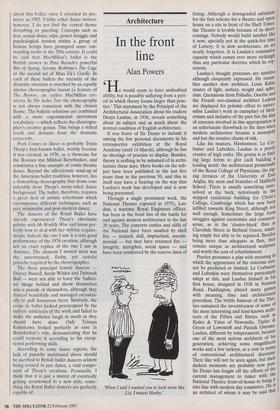Architecture
In the front line
Alan Powers
e would seem to have undoubted ability, but is possibly suffering from a peri- od in which theory looms larger than prac- tice.' This statement by the Principal of the Architectural Association about his student Denys Lasdun, in 1936, reveals something about its subject and as much about the normal condition of English architecture.
`H
It was brave of Sir Denys to include it among the few personal documents in his retrospective exhibition at the Royal Academy (until 16 March), although he has no shortage of practice to display. Besides, theory is nothing to be ashamed of in archi- tecture these days. More books on the sub- ject have been published in the last five years than in the previous 50, and this in itself may have a bearing on the way that Lasdun's work has developed and is now being presented.
Through a single prominent work, the National Theatre (opened in 1975), Las- dun, a wartime Royal Engineers officer, has been in the front line of the battle for and against modern architecture in the last 20 years. The concrete castles and cliffs of the National have been assailed by shell fire — stained, dull, impractical, uncom- mercial — but they have returned fire integrity, metaphor, social space — and have been reinforced by the reserve lines of
`When I said I wanted you to look more like Liz, I meant Hurley.' listing. Although a downgraded substitute for the first scheme for a theatre and opera house on a site in front of the Shell Tower, the Theatre is lovable because of its short- comings. Nobody would build another like it now, specially not in the quick-fire time of Lottery. It is slow architecture, an art nearly forgotten. It is Lasdun's ruminative capacity which comes over more strikinglY than any particular doctrine which he rep- resents.
Lasdun's thought processes are intuitive although eloquently expressed. He resem- bles another slow architect, Louis Kahn, master of light, surface, weight and apho- rism. Quotations from Palladio, Goethe and the French neo-classical architect LedouX are displayed for polemic effect to univer- salise Lasdun's work as exemplary of Mod- ernism and inclusive of the past but the hint of coercion involved in this appropriation is an unfortunate throwback to the days when modern architecture became a monopoly and lost the creative charm of risk.
Like his masters, Hawksmoor, Le Cor- busier and Lubetkin, Lasdun is a poetic creator of high order. His genius is in find- ing large forms to give each building a leading motif: the architectural promenade of the Royal College of Physicians, the zig- zag terraces of the University of East Anglia, the stem and branches of Hallfield School. There is usually something unre- solved at the back, notoriously in the stepped residential building for Christ s College, Cambridge which has now been 'dined towards King Street, although not well enough. Sometimes the large form struggles against economics and common- sense, as in the 'cluster-block' flats at Claredale Street in Bethnal Green, stand- ing empty but able to be repaired. Besides being more than adequate as flats, they remain unique as architectural sculpture and worth the cost of refurbishment.
Poetics presumes a play with meaning in which the appearance of the outcome Can- not be predicted or limited. Le Corbusier and Lubetkin were themselves particularly adept at this, and Lasdun himself in his first house, designed in 1938 in Newton Road, Paddington, played many games with meaning, time and architectural precedent. The brittle humour of the Thir- ties sustained the inventiveness of some of the most interesting and least-known archi- tects of the Fifties and Sixties, such as Ryder & Yates of Newcastle, Tayler Green of Lowestoft and Patrick GwYnne' Lasdun, different by temperament, became one of the most serious architects of his generation, achieving some magnificent works and a few turkeys, at a cost in terms of conventional architectural decorum• Their like will not be seen again, but their darkest moments are probably now past. Sir Denys has fought off the efforts of the current management to tinker with the National Theatre front-of-house to bring n into line with modern day commerce. He Is an architect of whom it may be said that
even his mistakes are important enough to be preserved.
The excitement of current architectural theory is that it is not rationalistic and dry. It can incorporate poetics for the making and reading of buildings. Lasdun has done a great service in travelling ahead on this road when many other architects would have denied its very existence.



























































 Previous page
Previous page